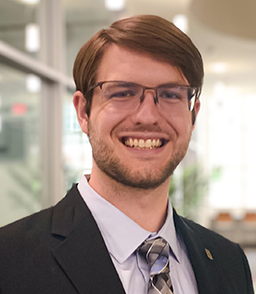Office: Gallogly Hall 420
Email Dr. Frickenstein
Alex Frickenstein
Assistant Professor
EDUCATION
- Ph.D., Biomedical Engineering, University of Oklahoma
- B.S., Chemical and Biological Engineering, Colorado State University
RESEARCH INTERESTS
- Engineering education
- Single particle elemental analysis
- Molecular diagnostics
PROFESSIONAL AND OUTREACH INTERESTS
During his doctoral training and research, Dr. Frickenstein focused on engineering and characterizing monodisperse gold nanoparticles for use in improving the quantification of nanoscale interactions between cells, proteins, and nanoparticles. Dr. Frickenstein specialized in quantification of inorganic nanoparticles through single particle inductively coupled mass spectrometry. Dr. Frickenstein’s current interests include:
- Engineering Education: improving accessibility, comprehension, and applicability of biomedical engineering knowledge and skills through enhancing instruction
- Virtual Learning Platforms: capitalizing on novel online opportunities for training biomedical engineers in higher education, professional, and industry pursuits
Dr. Frickenstein is not accepting Ph.D. students at this time.
SELECTED PUBLICATIONS
A complete list of Dr. Frickenstein’s publications can be found on Google Scholar.
- Frickenstein A*, Mukherjee S*, Harcourt T, He Y, Sheth V, Wang L, Malik Z, Wilhelm S, “Quantification of Biocompatible Monodisperse Gold Nanoparticles by SP-ICP-MS,” Analytical and Bioanalytical Chemistry, 2023, https://doi.org/10.1007/s00216-023-04540-x
- Yang W, Frickenstein A, Holden A, Sheth V, Mettenbrink E, Wang L, Woodward A, Joo B, Butterfield S, Donahue N, Green D, Thomas A, Harcourt T, Young H, Tang M, Malik Z, Harrison R, Mukherjee P, DeAngelis P, Wilhelm S, “Controlling nanoparticle uptake in innate immune cells with heparosan polysaccharides,” Nano Letters, 2022, 22 (17), 7119-7128, DOI: 10.1021/acs.nanolett.2c02226
- Donahue N, Sheth V, Frickenstein A, Holden A, Kanapilly S, Chady S, Wilhelm S, “Absolute quantification of nanoparticle interactions with individual human B cells by single cell mass spectrometry,” Nano Letters, 2022, 22 (10), 4192-4199, 10.1021/acs.nanolett.2c01037
- Zhang Y, Elechalawar C, Yang W, Frickenstein A, Asfa S, Fung K, Murphy B, Dwivedi S, Rao G, Dey A, Wilhelm S, Bhattacharya R, Mukherjee P, “Disabling partners in crime: gold nanoparticles disrupt multicellular communications within the tumor microenvironment to inhibit ovarian tumor aggressiveness,” Materials Today, 2022, 56, 79-95, DOI: 10.1016/j.mattod.2022.01.025
- Frickenstein A, Hagood J, Britten C, Abbott B, McNally M, Vopat C, Patterson E, MacCuaig W, Jain A, Walter K, McNally L, “Mesoporous Silica Nanoparticles: Properties and Strategies for Enhancing Clinical Effect,” Pharmaceutics, 2021, 13 (4), 570, DOI: 10.3390/pharmaceutics13040570
- Frickenstein A*, Jones M*, Behkam B, McNally L, “Imaging Inflammation and Infection in the Gastrointestinal Tract,” Int. J. Mol. Sci., 2020, 21 (1), 243, DOI: 10.3390/ijms21010243


